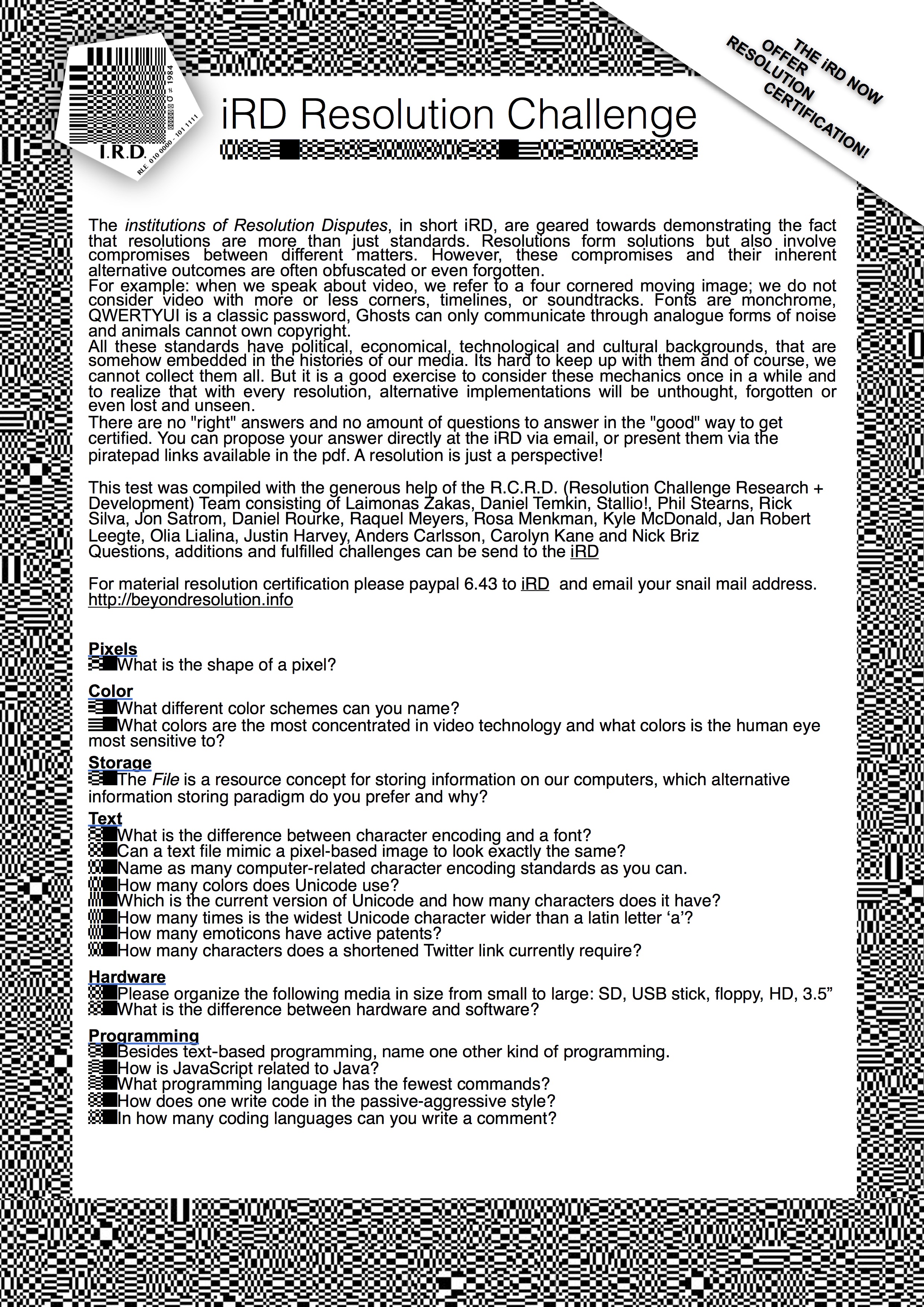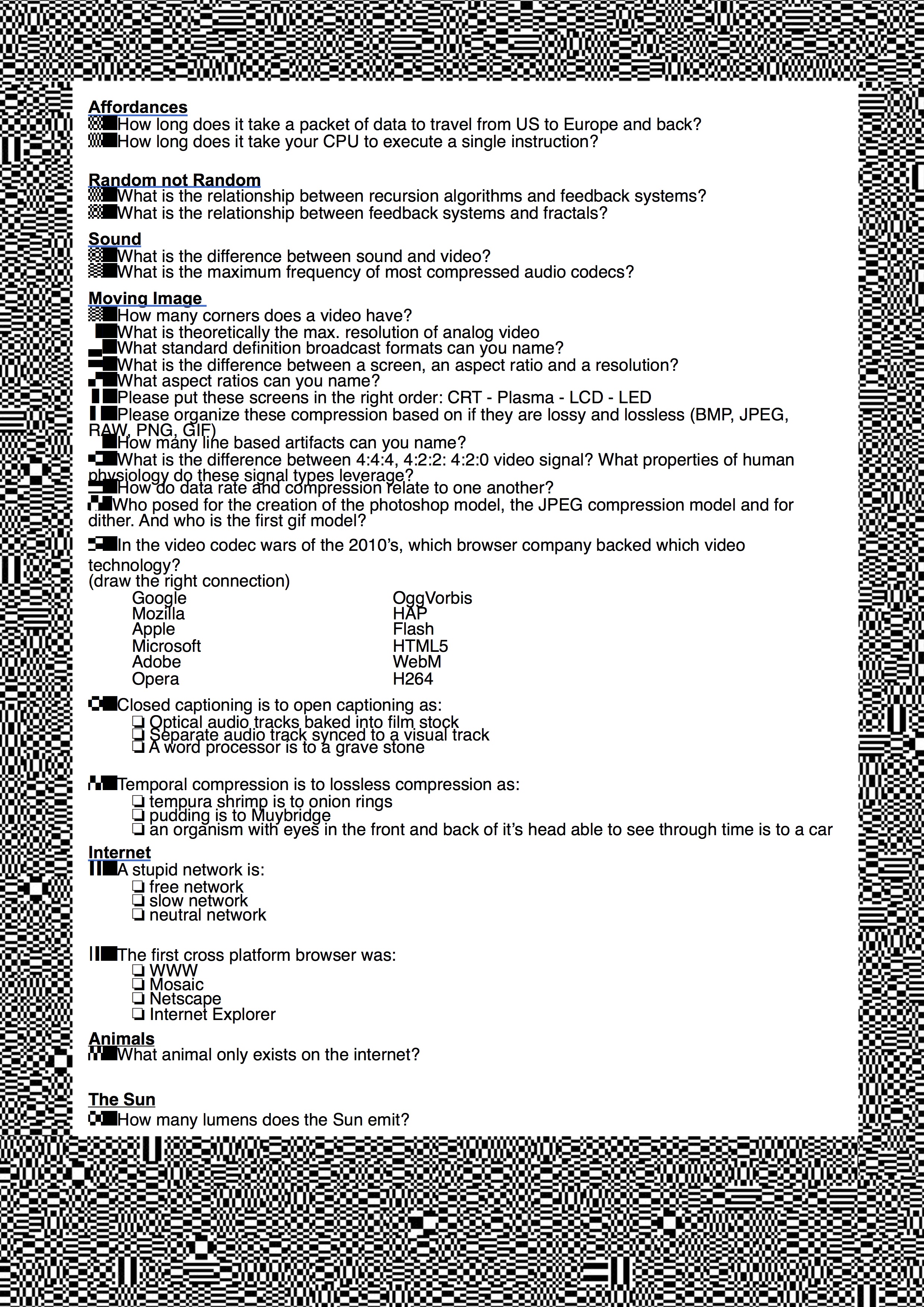
 The institutions of Resolution Disputes [iRD] call attention to media resolutions. While a ’resolution’ generally simply refers to a standard (measurement) embedded in the technological domain, the iRD reflect on the fact that a resolution is indeed a settlement (solution), but at the same time a space of compromise between different actors (objects, materialities and protocols) who dispute their stakes (framerate, number of pixels etc.) within the growing digital territories.
The institutions of Resolution Disputes [iRD] call attention to media resolutions. While a ’resolution’ generally simply refers to a standard (measurement) embedded in the technological domain, the iRD reflect on the fact that a resolution is indeed a settlement (solution), but at the same time a space of compromise between different actors (objects, materialities and protocols) who dispute their stakes (framerate, number of pixels etc.) within the growing digital territories.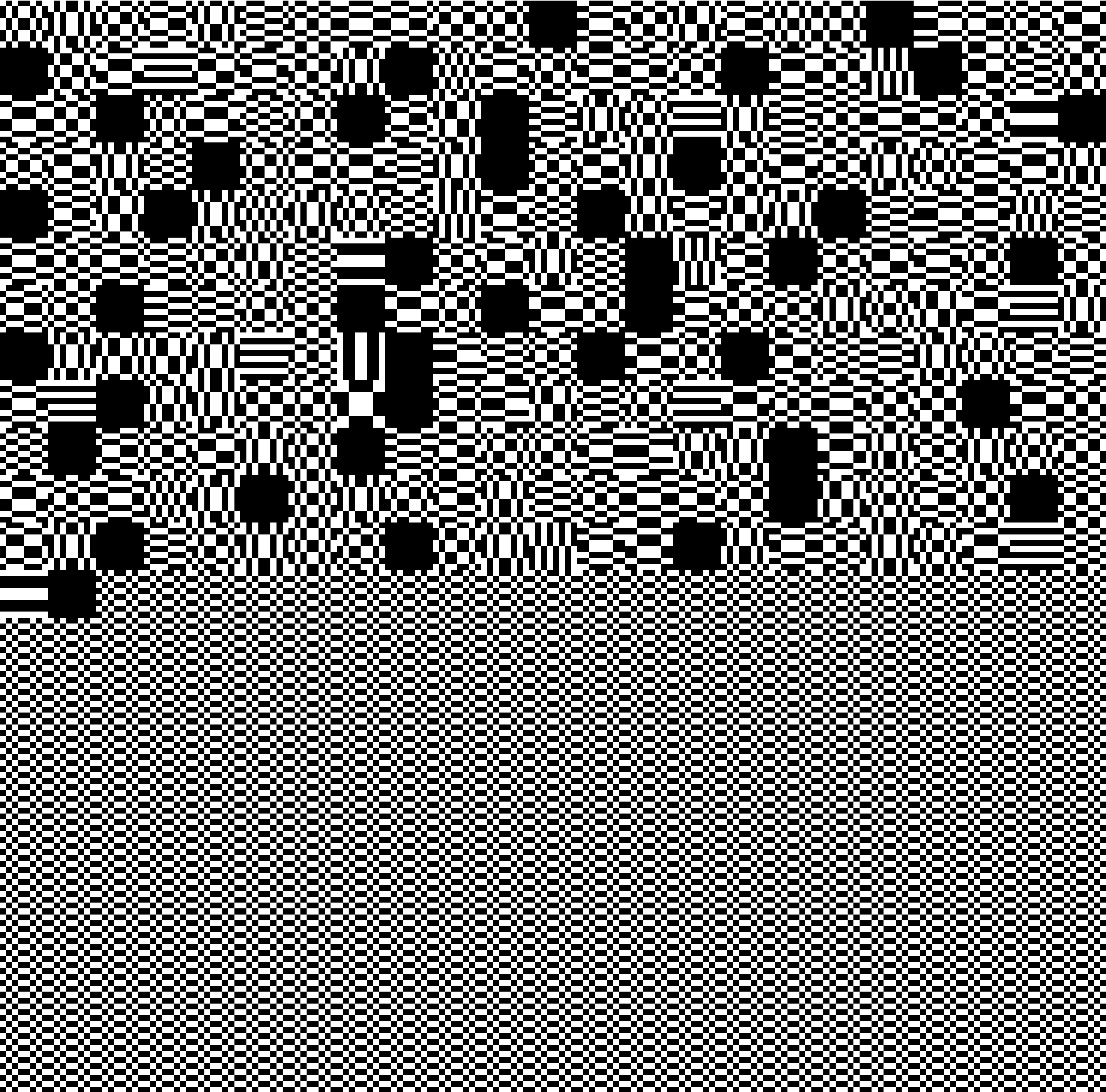 Resolutions inform both machine vision and human ways of perception. They shape the material of everyday life ubiquitously. They do this not just as an “interface effect”* but as hyperopic lens, obfuscating any other possible alternative resolution from the users media literacy.
Resolutions inform both machine vision and human ways of perception. They shape the material of everyday life ubiquitously. They do this not just as an “interface effect”* but as hyperopic lens, obfuscating any other possible alternative resolution from the users media literacy.
⠀▦▦▦▦▦▦▦▤▤▣▣▣▤ ⠀▦▦▦▦▦▦▤▤▣▣▣▤▤ ⠀▦▦▦▦▦▤▤▣▣▣▤▤▦ ⠀▦▦▦▦▤▤▣▣▣▤▤▦▦ ⠀▦▦▦▤▤▣▣▣▤▤▦▦▦ ⠀▦▦▤▤▣▣▣▤▤▦▦▦▦ ⠀▦▤▤▣▣▣▤▤▦▦▦▦▦ ⠀▤▤▣▣▣▤▤▦▦▦▦▦▦ ⠀▤▣▣▣▤▤▦▦▦▦▦▦▦ ⠀▤▣▣▣▤▤▦▦▦▦▦▦▦ ⠀▤▤▣▣▣▤▤▦▦▦▦▦▦ ⠀▦▤▤▣▣▣▤▤▦▦▦▦▦ ⠀▦▦▤▤▣▣▣▤▤▦▦▦▦ ⠀▦▦▦▤▤▣▣▣▤▤▦▦▦ ⠀▦▦▦▦▤▤▣▣▣▤▤▦▦ ⠀▦▦▦▦▤▤▣▣▣▤▤▦▦ ⠀▦▦▦▦▦▤▤▣▤▤▦▦▦ ⠀▦▦▦▦▦▦▤▣▤▦▦▦▦ ⠀▦▦▦▦▦▦▦▣▦▦▦▦▦ ⠀▦▦▦▦▦▦▦▣▦▦▦▦▦
RESOLUTIONS INFORM BOTH MACHINE VISION AND HUMAN WAYS OF PERCEPTION.
THEY ARE THE MATERIAL OF EVERYDAY LIFE(1),
UBIQUITOUS, WHILE HUMANS HAVE GONE MOSTLY OBLIVIOUS. iRD STRIVES FOR A RADICAL MATERIALIST re-(RE-)DISTRIBUTION OF THE SENSIBLE.(2)
Even the most glitchy-glitch is just the vernacular of an already present, not evenly distributed future. When we walk inside these futures we find ourselves momentarily stuck inside a pocket of ambiguous ‘freespace’, a place of inspiration and curiosity. Until we find - momentary - resolve.
Resolutions inform both machine vision and human ways of perception. Rules, or protocols, change data in order to store, show, move and connect between technologies. Protocols, together with objects and their materialities, form the resolutions that make technology run smoothly(3). But these resolutions form not only a solution, but also a compromise between multiple underlying media properties.
A resolution is not a neutral facility but carries historical, economical and political ideologies. The cost of all of these media protocols is that we have gradually become unaware of the choices and compromises they represent. We are collectively suffering from technological hyperopia where these qualities have moved beyond a fold of perspective.
RESOLUTIONS INVOLVE < DETERMINATIONS >
/* –AND LOST ALTERNATIVES– */
Have we become bad at constructing our own resolutions, or are we just oblivious to resolutions and their inherent compromises?
The i.R.D. calls attention to media resolutions and does not /just/ aestheticize their formal qualities or denounce them as ‘Evil’ (4). iRD intends to expose methods of ‘creative problem creating’ (5), to bring authorship back to the actors involved during the building of a ‘resolution’.
While the gospel of resolutions sings about new standards implemented through corruption, iRD displays forms of vernacular resistance based on misleading, false, or ambiguous data and maybe a chanting jabberwocky, venturing along the bootleg trails above a Sea of Fog.
1. Michel de Certeau, The Practice of Everyday Life, 1984.
2. Jacques Ranciere, The Politics of Aesthetics, 2004.
3. Alexander Galloway, Protocol, 2006.
4. Matthew Fuller, Andrew Goffey, Evil Media, 2012.
5. jon.satrom, creative problem creating, 2013. ︎ Transfer gallery page

︎ A tour of Internet Yami-ichi, the offline Internet flea market (featuring the i.R.D.) by Regine Debatty @We Make Money Not Art.
institutions of Resolution Disputes [ i.R.D. ], long version:
Even though the iRD mimics an institute, in reality it is not a classic, institutional organ. Instead, the iRD multiplexes the term institution, by revisiting its usage in the late 1970s. In this context, formulated by Joseph Goguen and Rod Burstall, institution refers to a slightly ‘more compound framework’, that deals with the growing complexities, connecting different logical systems (such as databases and programming languages) within computer sciences. A main result of these non-logical institutions is that different logical systems can be glued together at a substrata level, forming illogical frameworks through which computation also takes place.
Inspired by the idea of hyper functional, yet illogical frameworks, the iRD is dedicated to researching the interests of anti-utopic, obfuscated, lost and unseen, or simply ‘too good to be implemented’ resolutions.
The institutions of Resolution Disputes [iRD] call attention to media resolutions. While a resolution generally simply refers to a determination of functional settings in the technological domain, the iRD stresses that a resolution is indeed a settlement (solution), but at the same time also entails a space of compromise between different actors (objects, materialities, and protocols) in dispute over norms (frame rate, number of pixels etc.). Common settings can ossify as generally accepted requirements or de facto standards, while others standards are notated as norms by standardizing organizations such as the International Organization for Standardization. We call this progress*.
Resolutions are non-neutral standard settings that involve political, economical, technological and cultural values and ideologies, embedded in the genealogies and ecologies of our media. In an uncompromisingly fashion, quality (fidelity) speed (governed by efficiency) volume (generally encapsulated in tiny-ness for hardware and big when it comes to data) and profit (economic or ownership) have been responsible for plotting the vector of progress. This dogmatic configuration of belief x action has made upgrade culture a great legitimizer of violence, putting its insufficient technological resolutions to rest. While a resolution can thus be understood as a manifold assemblage of common, but contestable standards, it should also be considered in terms of other options; those that are unknown and unseen, obsolete and unsupported.
Resolutions inform both machine vision and human ways of perception. They shape the material of everyday life ubiquitously. As the media landscape becomes more and more compound, or in other words, an heterogenous assemblage in which one technology never functions on its own, its complexities have moved beyond a fold of everyday settings. Technological standards have compiled into resolution clusters; media platforms that form resolutions like tablelands, flanked by steep cliffs and precipices looking out over obscure, incremental abysses that seem to harbor a mist of unsupported, obsolete norms.
The platforms of resolution now organize perspective. They are the legitimizers of both inclusion and exclusion of what can not be seen or what should be done, while the fog, the other possibilities become more and more obscure.
It is important to realize that the resolutions platforms are not inherently Evil*. They can be impartial. It is important that we unpack these resolutions and note that they are conditioning our perception. A culture that adheres to only one or few platforms of resolutions supports nepotism amongst standards. These clusters actively engage simpleness and mask the issues at stake, savoring stupidity, and are finally bound to escalate into glutinous tech-fascism.
The question is, have we become unable to construct our own resolutions, or have we become oblivious to them?
Resolutions work not just as an interface effect* but as hyperopic lens, obfuscating any other possible alternative resolutions from the users screens and media literacy. When we speak about video, we only ever refer to a four cornered moving image. Why do we not consider video with more or less corners, timelines, or soundtracks. Fonts are monochrome; they do not come with their own textures, gradients or chrominance and luminance mapping. Text editors still follow the lay-out of paper; there is hardly any modularity within written word technologies. Even ghosts, the figments of our imagination, have been conditioned to communicate exclusively through analogue forms of noise (the uncanny per default), while aliens communicate through blocks and lines (the more intelligent forms of noise). We are hiking the resolution platforms comfortably. Unknowingly suffering from technological hyperopia, We have lost track of the compromises that are at stake inside our resolutions and are staring at the screens showing us mirage after mirage.
A resolution is the lens through which constituted materialities become signifiers in their own right. They resonate the tonality of the hive mind and constantly transform our technologies into informed material vernaculars.
Technology is evolving faster than we, as a culture can come to terms with. This is why determinations such as standards are dangerous; they can preclude the alternative. The radical digital materialist believes in informed materiality*: while every string of data is ambiguously fluid and has the potential to be manipulated into anything, every piece of information functions within /*adhesive/ encoding, contextualization and embedding. Different forms of ossification slither into every crevice of private life, while unresolved, ungoverned free space seems to be slipping away. There lies the power of standardization.
We are in need for a re-(Re-)Distribution of the Sensible.
The iRD offers a liminal space for resolution studies. Resolution studies is not only about the effects of technological *progress or about the esthetization of the scales of resolution. Resolution studies is a studies on how resolution embeds the tonalities of culture, in more than just its technological facets.
Resolution studies researches the standards that could have been in place, but are not. As a form of vernacular resistance, based on the concept of providing ambiguous resolutions, the iRD employs the liminal resolution of the screen as a looking-glass. Here, hyperopia is fractured and gives space to myopia, and visa versa. This is how iRD exposes the colors hidden inside the grey mundane objects* of everyday life.
The iRD is not a Wunderkammer for dead media*, but a foggy bootleg trail for vernacular resistance.
Progress has fathered many dead technologies. A Wunderkammer, or curiosity cabinet of media resolutions would celebrate these dead objects by trapping them inside a glass bell, relieving them in-definitely of their action radius. While the iRD adheres to the settlements of governing media resolutions, it also welcomes ventures along the bootleg trails of the tactical undead*. These undead move beyond resolution, through the literacies of the governing techno cultures, into liminal spaces. They follow the wild and uncanny desire paths that cut through sensitive forms and off-limit areas into speculative materialities*. They threaten the status quo of secure forms of media and provide the ambiguity that is so necessary for inspiration, action and curiosity*.
The iRD believes that methods of creative problem creation* can bring authorship back to the layer of resolution setting. Resolution theory moves against what sometimes seems like an unsolvable puzzle of flattening reality, while the iRD might seem like a one way trail straight into the Sea of Fog and towards the abyss of techno-norms. But it could also be a modular framework that opens and expands standards through inspection and reflection. As any good theory of media, resolution theory is a theory on literacy. Literacy of the machines, the people, the people creating the machines and the people being created by the machines. Through challenging the platforms of resolution, it can help the wanderer to scale actively between these states of hyperopia and myopia. It can uncover crystal cities of fog as well as shine a light on the soon to be distributed futures. Here we can mine for the timonds.
︎ official Transfer Gallery page
︎ An in depth all info PDF about this work
︎ Resolution Challenge!
︎ the essay
BACKGROUND INFORMATION
The i.R.D. first opened in 2015 at Transfer Gallery New York, where they took the form of 5 institutions (statements) encoded in DCT.
During this initial opening, the i.R.D. shed light on the different complexities of of compression ecologiesn by showcasing their different complexities.
Since their 2015 initiation, the i.R.D. have been actively disseminating information on Resolutions and their inherent compromises in the form of interventions via:
- annual flower laying at the ISO premises during the World Standard Day to commemorate resolutions that have become obsolete
- offering resolution certification through the Resolution Challenge,
- active archivation of standards through the DCT DeCalibration Target and the DCT Repo.
- The i.R.D. are also responsible for initiating the DeCalibration Army.
Works from the different ecologies of compression complexities that were on display in the initial opening of the i.R.D.:
⌁ :: Analogue :: Collapse of PAL / Beyond Resolution
• :: Dots/pixels :: Un/Resolved
━ :: Line :: WHITEOUT
▩ :: Block :: DCT
⌇ :: Wavelet :: Myopia
⟗ :: Vectors :: Shredded Hologram Pen/Rose
COVERAGE
‘Resolution Disputes: A Conversation Between Rosa Menkman and Daniel Rourke’, Furtherfield
“By using the terms ‘obfuscation’ and ‘dysfunction’ you are invoking a will – perhaps on your part, but also on the part of the resolutions themselves – to be recognised. I love that gesture. I can hear the objects in iRD speaking out; making themselves heard, perhaps for the first time.”
‘Accidental Vision’, Postmatter“The boundaries of the screen are challenged in Rosa Menkman’s new exhibition at TRANSFER Gallery, using technological error to disrupt expectations.”
‘Having Cryptic Conversations about Encrypted Graphics’, The Creator’s Project“ Rosa Menkman’s new media artwork celebrates both the computer screen glitch and the actual resolution of the image it’s trying—and failing—to represent, highlighting the accidents in the “free space” between them.”
 The question is, ‘have we become unable to construct our own resolutions, or have we become oblivious to them?’ Either way we are in need for another re-“(Re-)Distribution of the Sensible”.
The question is, ‘have we become unable to construct our own resolutions, or have we become oblivious to them?’ Either way we are in need for another re-“(Re-)Distribution of the Sensible”.
 iRD intend to impose methods of “creative problem creation” to bring authorship back to the layer of setting a 'resolution'. The radical digital materialist believes in an “informed materiality”; while every string of data is ambiguously fluid and has the potential to be manipulated into anything, every piece of information functions within /adhesive*/ encoding, contextualization and embedding (etc).
iRD intend to impose methods of “creative problem creation” to bring authorship back to the layer of setting a 'resolution'. The radical digital materialist believes in an “informed materiality”; while every string of data is ambiguously fluid and has the potential to be manipulated into anything, every piece of information functions within /adhesive*/ encoding, contextualization and embedding (etc).
 Through iRDs tactics beyond resolution, the otherwise grey mundane objects of everyday-life show their colors. iRD is not a wunderkabinet of dead media, but a foggy bootleg trails for vernacular resistance.
Through iRDs tactics beyond resolution, the otherwise grey mundane objects of everyday-life show their colors. iRD is not a wunderkabinet of dead media, but a foggy bootleg trails for vernacular resistance.▣▣▣▣▣▣▣▣▣▣▣▣▣
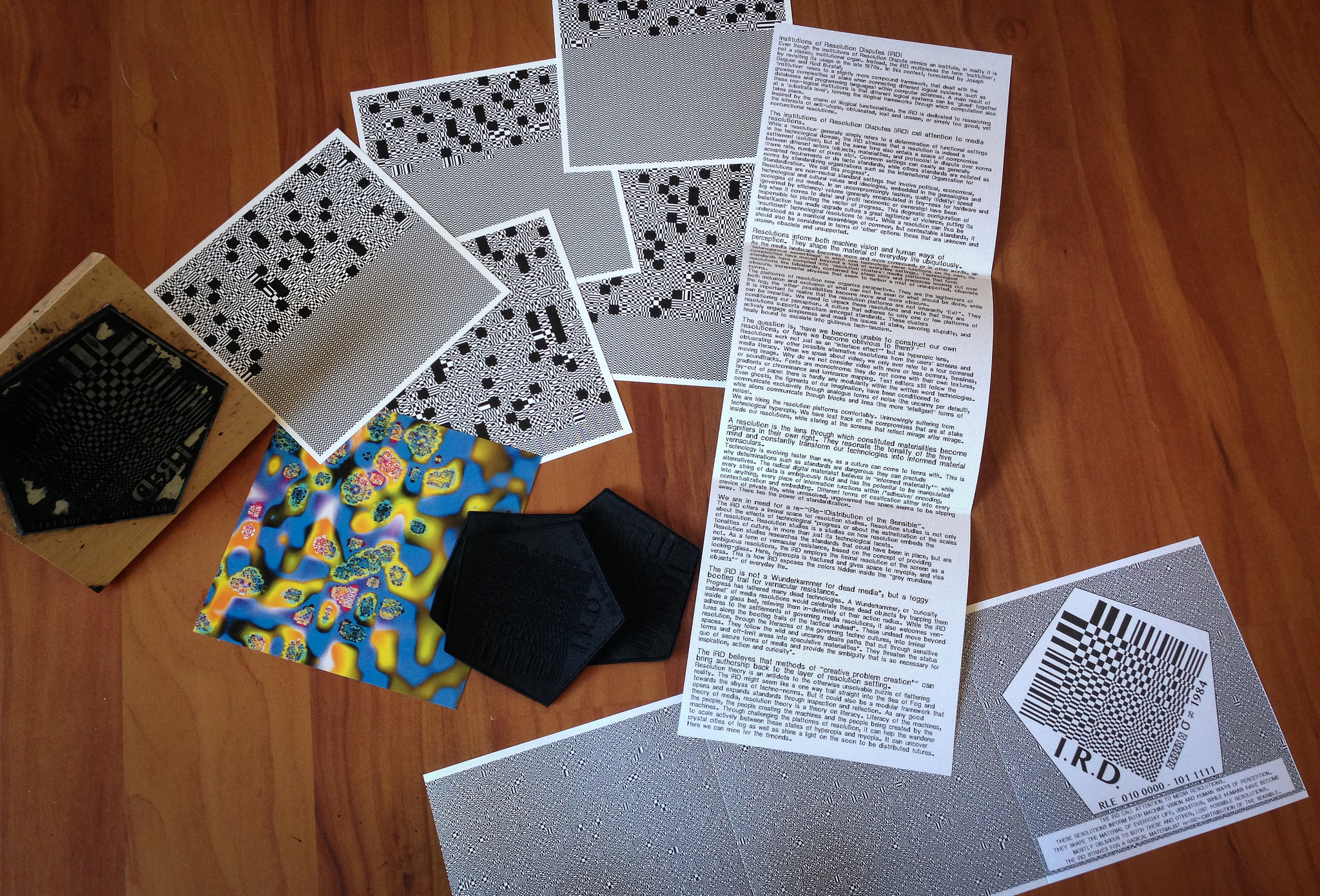
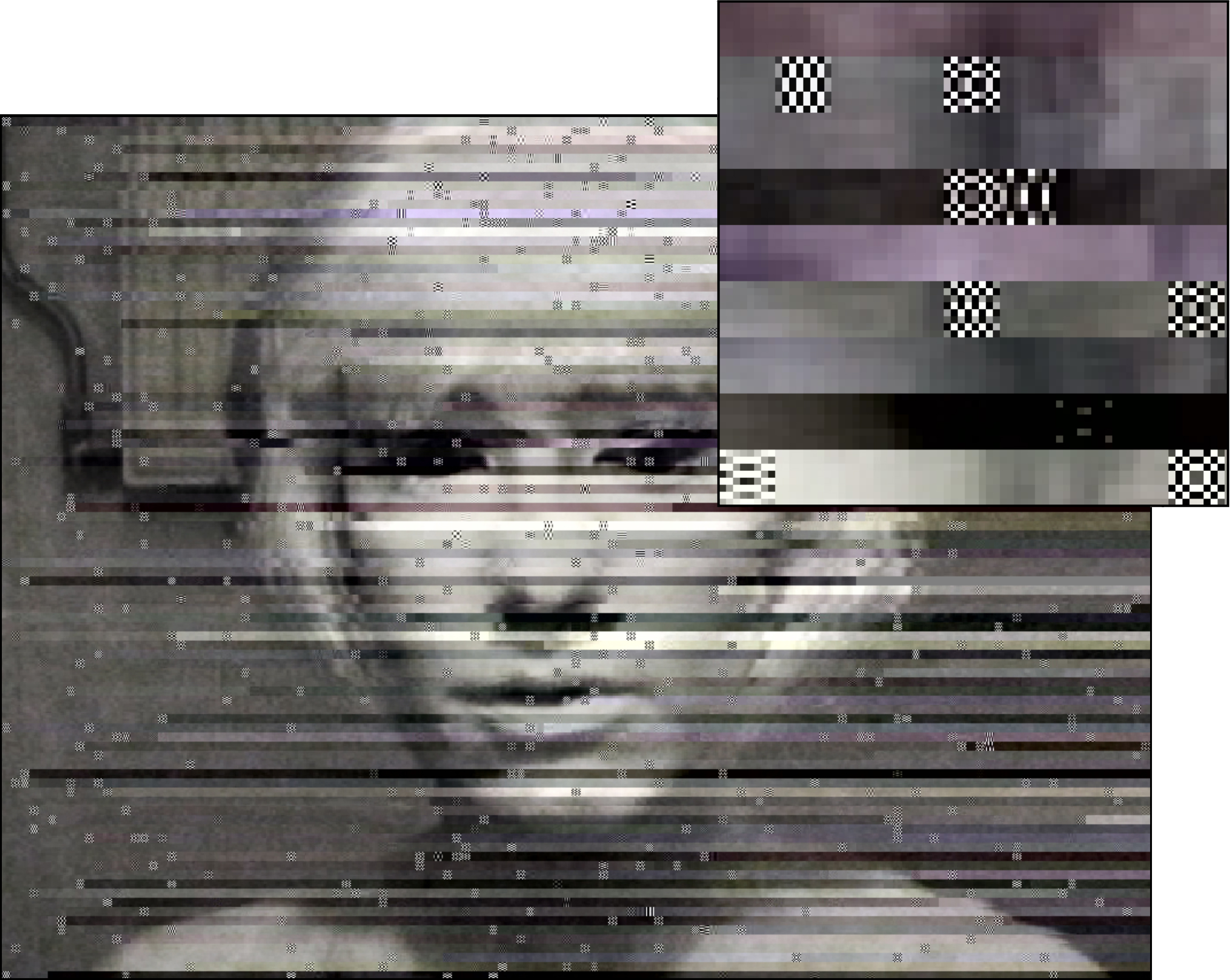 Revealing the surface and structure of the image
A side effect of the JPEG compression is that the limits of the images’ resolution – which involve not just the images’ number of pixels in length and width, but also the luma and chroma values, stored in the form of 8 x 8 pixel macroblocks – are visible as artifacts when zooming in beyond the resolution of the JPEG.
Revealing the surface and structure of the image
A side effect of the JPEG compression is that the limits of the images’ resolution – which involve not just the images’ number of pixels in length and width, but also the luma and chroma values, stored in the form of 8 x 8 pixel macroblocks – are visible as artifacts when zooming in beyond the resolution of the JPEG.
Because the RGB color values of JPEG images are transcoded into Y’CbCr macroblocks, accidental or random data replacements can result into dramatic discoloration or image displacement. Several types of artifacts can appear; for instance ringing, ghosting, blocking, and staircase artifacts. The relative size of these artifacts demonstrates the limitations of the JPEGs informed data: a highly compressed JPEG will show relatively larger, block-sized artifacts.
<href: Hito Steyerl: How Not to Be Seen, 2013>
The legibility of an encrypted message does not just depend on the complexity of the encryption algorithm, but also on the placement of the data of the message. Here they are closely connected to resolutions: resolutions determine what is read and what is unseen or illegible.
DCT ENCRYPTION (2015) uses the aesthetics of JPEG macroblocks to mask its secret messages on the surface of the image, mimicking error. The encrypted message, hidden on the surface is only legible by the ones in the know; anyone else will ignore it like dust on celluloid.
While the JPEG compession consists of 6 steps, the basis of the compression is DCT, or Discrete Cosine Transform. During the final, 6th step of the JPEG compression, entropy coding, a special form of lossless data compression, takes place. Entropy coding involves the arranging the image components in a "zigzag" order, using run-length encoding (RLE) to group similar frequencies together.
How Not to be Read, a recipe using DCT:
︎ for the #3D Additivist Cookbook.
︎ DCT won the Crypto Desgin Challenge Award in 2015.
A PDF with this work is downloadable here
The legibility of an encrypted message does not just depend on the complexity of the encryption algorithm, but also on the placement of the data of the message. Here they are closely connected to resolutions: resolutions determine what is read and what is unseen or illegible.
DCT ENCRYPTION (2015) uses the aesthetics of JPEG macroblocks to mask its secret messages on the surface of the image, mimicking error. The encrypted message, hidden on the surface is only legible by the ones in the know; anyone else will ignore it like dust on celluloid.
While the JPEG compession consists of 6 steps, the basis of the compression is DCT, or Discrete Cosine Transform. During the final, 6th step of the JPEG compression, entropy coding, a special form of lossless data compression, takes place. Entropy coding involves the arranging the image components in a "zigzag" order, using run-length encoding (RLE) to group similar frequencies together.
How Not to be Read, a recipe using DCT:
- Choose a lofi JPEG base image on which macroblocking artifacts are slightly apparent. This JPEG will serve as the image on which your will write your secret message.
- If necessary, you can scale the image up via nearest neighbour interpolation, to preserve hard macroblock edges of the base image.
- Download and install the DCT font
- Position your secret message on top of the JPEG. Make sure the font has the same size as the macroblock artifacts in the image
- Flatten the layers (image and font) back to a JPEG. This will make the text no longer selectable and readable as copy and paste data.
︎ for the #3D Additivist Cookbook.
︎ DCT won the Crypto Desgin Challenge Award in 2015.

 A Discrete Cosine Transform simplified to make a monochrome .ttf font and iRD logo. In the logo RLE 010 000 - 101 1111 signifies the key to the DCT encryption: 010 000 - 101 1111 are the binary values of the 64 most used ASCII glyphs, which are then mapped onto the DCT in a zig zag order (following RLE).
A Discrete Cosine Transform simplified to make a monochrome .ttf font and iRD logo. In the logo RLE 010 000 - 101 1111 signifies the key to the DCT encryption: 010 000 - 101 1111 are the binary values of the 64 most used ASCII glyphs, which are then mapped onto the DCT in a zig zag order (following RLE).
black on black
embroidered patch
with logo iRD
the patch reads:
σ ≠ 1984
(stealth does not equal 1984)
and RLE (run length encoding 0100000 - 1011111
RLE 010 000 - 101 1111 signifies the key to the DCT encryption: 010 000 - 101 1111 are the binary values of the 64 most used ASCII glyphs, which are then mapped onto the DCT in a zig zag order (following RLE).
A PDF about this work is downloadable here
i.R.D. Patch
[including the key to DCT]![]()
[including the key to DCT]


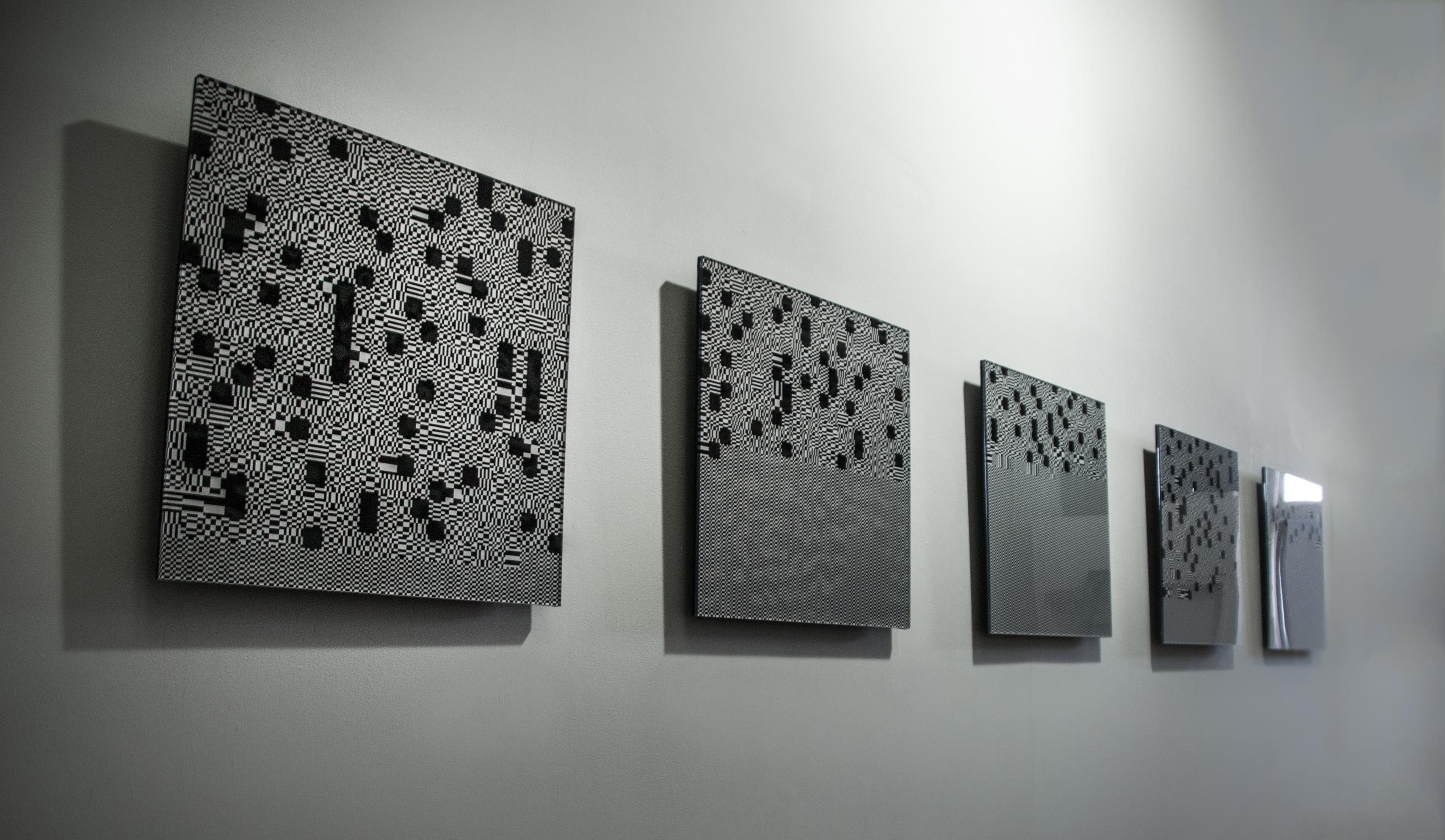 5 institutions encoded in DCT. A publication in 5 Acrylics / postcards /
5 institutions encoded in DCT. A publication in 5 Acrylics / postcards / 